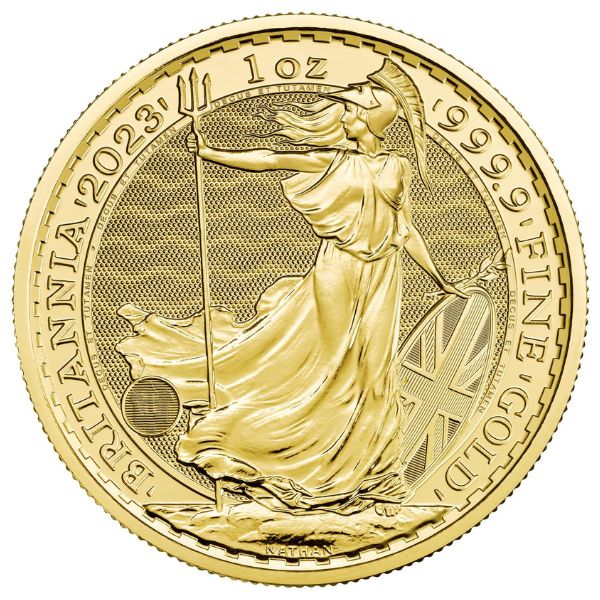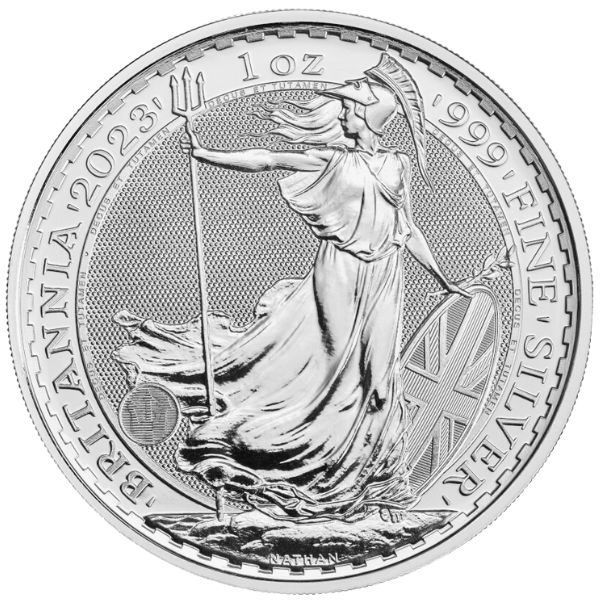The Untold Story of How Isaac Newton Saved British Coinage

Isaac Newton is known primarily for his contributions to the scientific world. His achievements are too numerous to count. The brilliant British polymath is credited with the discovery of gravity, the invention of calculus, and more. To some, Newton may be the single most influential and important scientist in the history of mankind.
Everybody knows the story behind Newton’s discovery of gravity. He was sitting underneath a tree and observed an apple falling. While historians debate the veracity of this event and the role it played in Newton’s groundbreaking work, it has cemented itself as a legend in the public consciousness.
But a lesser known achievement of Newton’s life is often underreported by scholars of this enigmatic British genius. In the last decades of his life, Newton turned away from most of his scientific efforts, focusing his attention instead on a new hobby: coinage.
Over the course of thirty years, Newton revolutionized the Royal Mint. Even today, Isaac Newton’s work at Great Britain’s national mint continues to influence the bullion goliath’s reputation and culture.
Newton: A Revolutionary Thinker
Most readers already know who Isaac Newton was. To many, he’s mostly known as the father of gravity. In Philosophiae Naturalis Principia Mathematica, Newton established his laws of motion, as well as the law of universal gravitation. Together, these theories provide the foundation for almost all of modern physics and natural philosophy.
Isaac Newton’s interests, however, pulled him in all sorts of directions. Aside from the discovery of gravity and a unified theory on the laws of motion, Newton’s prolific career included both the creation of calculus and the law of color. Both of these discoveries are foundational to industries everywhere.

Today, we have Newton to thank for an unprecedented number of scientific theories, mathematical concepts, and technologies.
For coin collectors, however, the most important part of Isaac Newton’s life happened long after he discovered gravity, explained the principles of how optics functioned, and crafted an entirely new branch of mathematics.
Newton and the Royal Mint
Throughout his revolutionary academic career, Newton frequently shifted interests. During the last thirty years of his life, he became preoccupied with coinage to the point of obsession. According to some historians, Isaac Newton’s interest in coinage may have stemmed from his intense focus on alchemy.
That’s right – Isaac Newton was positively obsessed with alchemy. According to his writings, his ultimate goal was to find the legendary “Philosopher’s Stone,” a mythical object capable of turning ordinary materials into gold.
It’s no surprise, then, that Newton’s curious mind eventually turned to coinage. Already a prolific scientist and a member of England’s parliament, he approached the British Royal Mint sometime in 1696.
Background: An Economy in Ruins
When Isaac Newton offered his services to the Royal Mint, his help couldn’t have come at a better time. During the 1680s and 1690s, counterfeiting of British coins had gotten completely out of control. According to Newton, around 20% of coins collected during one study in the 1690s were counterfeits.
For anyone with a basic understanding of coinage, this is a huge problem. Without the ability to trust coinage, British citizens would be unable to effectively trade and barter.
Imagine how bad it would be if 20 percent of United States Dollars were counterfeit!
Counterfeit Coins – A Monetary Nightmare
By Newton’s own calculations (which we tend to trust), a stunning one out of five British coins were counterfeits when he stepped up to take control of the Royal British Mint. The Master of the Mint is a title given to the person in charge of the operation of the Royal Mint, Britain’s sole source of circulation coins.
The role existed up until 1870, when it was assumed by the Chancellor of the Exchequer. Nowadays, the Chancellor is naturally the Master of the Mint. But before this change, the Master of the Mint was its own position – and a powerful one at that!
Newton as Master of the Mint
As Master of the Mint, Isaac Newton put his brilliance to work combating the influx of counterfeits plaguing the British coinage economy. At the time, counterfeiting wasn’t just a crime – it was considered a severe felony.
Even before Newton, counterfeiting was classified as an act of high treason punishable by death. Historians note several examples of people who had been executed for counterfeiting British currency.
Newton aggressively pursued counterfeiters, shutting down several prominent forgery operations and having their proprietors executed.
How Isaac Newton Saved British Coinage
Like with most of his endeavors, Isaac Newton brought both passion and brilliance to his work at the Royal Mint. As Master of the Mint, he revolutionized British coinage and helped shape the Royal British Mint into the goliath of standardized coinage we love today.
Newton’s Contributions
Isaac Newton’s contributions to the new coinage system of Great Britain can be sorted into four main categories: new Assay procedures, spotting counterfeits, prosecuting forgers, and standardizing coinage.
Together, these four efforts saved British coinage and helped make the British Royal Mint one of the world’s most consistent and effective producers of gold and silver coins.
Assay Procedures
Assaying refers to the process of determining the purity of a gold, silver, or platinum product. Assay certifications are provided for many of our bullion coins and bars, providing customers with verification of the actual purity of their precious metals.
Isaac Newton didn’t invent this process, but he did succeed in standardizing it for use at the Royal British Mint. Assaying is now a standard part of how the British Royal Mint maintains its strict quality standards – and we have Newton to thank for this!

Spotting Counterfeits
Newton was especially adept at spotting counterfeit coins. Even before he worked for the Royal Mint, Isaac Newton developed theories on how to reliably identify a counterfeit silver or gold coin.
He wasn’t the only person that could spot counterfeit coins, but historical records show that he was as prolific at this process as he was at almost everything the genius scientist did. Under his patronage, the Royal Mint developed new tools for quickly assessing the legitimacy of bullion coins produced as currency.
Remember: counterfeit coins are a massive problem. While most modern governments use paper currency, the Great Britain of Isaac Newton’s era relied primarily on coins for their legal tender. This means that counterfeit coins posed a threat to more than just collectors – they were a problem for the entire country’s economy.
Prosecuting Forgers
Newton hated counterfeiters. Counterfeiting is illegal in every country, but it used to be considered high treason in Great Britain. For crimes of high treason, the penalty was often death. Still, government officials had trouble finding the leaders of prominent counterfeiting operations.
After all, mints back in the 1600s didn’t have the sophisticated technology that benefits the Royal Mint today. Spotting the differences between legitimate and forged coins was very difficult, so identifying and prosecuting counterfeiters was nearly impossible.
This all changed when Sir Isaac Newton presented himself to the Royal Mint as their new Master of the Mint.
Think Isaac Newton can’t get any more interesting? He was one of Britain’s most prolific undercover agents during his time at the Royal Mint. He wore disguises, hiding out at bars and other places where counterfeit coinage might change hands. Newton was even able to declare himself a judicial officer in every major British territory.
Using these tools, Isaac Newton was nearly single-handedly responsible for prosecuting around 28 counterfeiters who had been distributing fake coins to the public. Just think about that. In 2014, the United States government successfully arrested 478 counterfeiters. They did this using the over 7,000 agents affiliated with the Secret Service, which is in charge of catching counterfeiters.

With minimal support, Isaac Newton managed to gather evidence leading to the arrest of 28 counterfeiters in a much smaller country – with far less sophisticated technology.
Standardizing Coinage
Once he’d worked to identify fakes and prosecute counterfeiters, Isaac Newton was able to make his greatest contribution to British coinage: standardization. Over the course of the over 1,000 years that the British Royal Mint has been in operation, there have been multiple attempts at standardizing coinage.
But few were as successful as the operation run by Isaac Newton. Under his leadership, Isaac Newton managed to create a slew of tools to help the Royal Mint keep their coins consistent. Aside from revolutionizing the Royal Mint’s Assaying certification procedures, he also put into place measures to help the Royal Mint improve its process for verifying the consistency of their bullion coins.
The Modern British Royal Mint
Today, the Royal Mint is one of the world’s most respected producers of gold, silver, and platinum coins. The use of coinage isn’t quite as widespread as it used to be, but the British Royal Mint is still responsible for creating millions of circulation coins each year.
But Newton’s influence also extends to bullion coins. All over the world, collectors use British bullion coins to stack silver, gold, and platinum. Even Royal Mint Gold Bars are endowed with a level of consistency and reputation that very few other mints can offer.
When you buy bullion products, it’s important to consider your exit strategy. Whether you plan to hold your bullion for a decade or you want to sell it within one year, we recommend going with bars and coins from a mint with a stellar reputation.
And when it comes to stellar reputations, it doesn’t get much better than the Royal Mint. The company’s coins and bars are remarkably consistent, and it’s almost impossible to find a product from their inventory that doesn’t meet their standards.
Tracking Newton’s Influence
We have Isaac Newton to thank for all of this. In just thirty years, he did things that nobody in the British government had been able to do in a thousand years. Newton used his brilliance to revolutionize British coinage and bring the Royal Mint to the forefront of modern bullion production.
The modern British Royal Mint is a far cry from what it used to be. While the mint’s responsibility was initially just to produce gold and silver coins for circulation, the British Royal Mint of 2024 produces hundreds of thousands of gold and silver coins for investors annually.
None of this would be possible, were it not for the standardization efforts imposed by Master of the Mint Sir Isaac Newton. In addition to prosecuting the counterfeiters plaguing British coinage, he ushered in a whole new era of consistency in the British Royal Mint.
A Goliath of Consistent Coinage
Of all the accolades given to the British Royal Mint, their biggest is likely consistency. British coinage is respected around the world for its purity, beauty, and meticulous design. Even in 2024, we find that the British Royal Mint’s gold, silver, and platinum coins are among the purest on the planet.
In fact, Newton’s influence goes even further. When the British Empire was at its height, the Royal Mint established subsidiaries around the world in its colonies. Two of these subsidiary mints include the Perth Mint and the Royal Canadian Mint.
These two mints are also known for their consistency and impeccable reputation. It wouldn’t be fair to attribute the success of the Royal Canadian Mint entirely to Isaac Newton, but it’s clear that his influence continues to resonate across the bullion market.
Final Thoughts: Isaac Newton Saved British Bullion
Isaac Newton was a revolutionary thinker. His work in multiple fields paved the way for many of the scientific achievements we’ve witnessed in the past century. Even the world of precious metals fails to escape the gargantuan influence of Isaac Newton.
While his biggest contributions to humanity may have been in the natural sciences, it’s impossible to deny how Isaac Newton revolutionized coinage in Great Britain – and the world.
This is the untold story of how Isaac Newton saved British coinage.
You might also be interested in:
About The Author
Michael Roets
Michael Roets is a writer and journalist for Hero Bullion. His work explores precious metals news, guides, and commentary.
